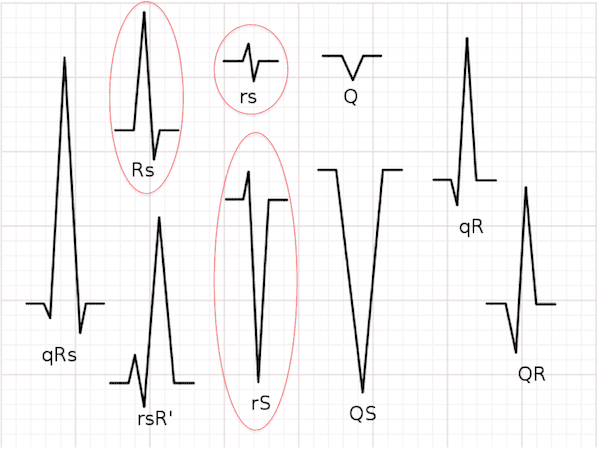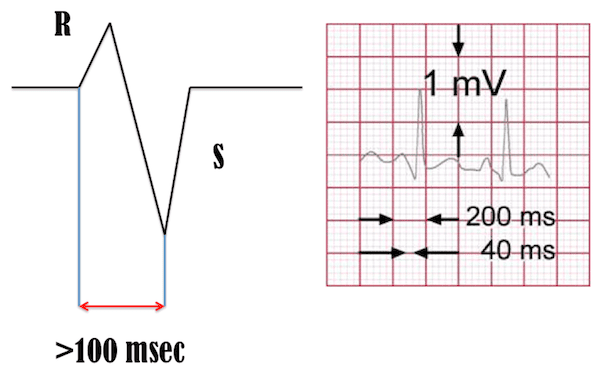

The Brugada criteria algorithm involves 4 sequential questions. If at any point, the answer is YES, then it is VT. [1]
1. Is there an absence of an RS complex in all precordial leads?
- Yes = VT (Sensitivity 0.21, specificity 1.0)
- No = Next question

2. Is the R to S interval >100 msec (2.5 small boxes) in one precordial lead?
- Yes = VT (Sensitivity 0.66, specificity 0.98)
- No = Next question

3. Is there atrioventricular (AV) dissociation?
- Yes = VT (Sensitivity 0.82, specificity 0.98)
- No = Next Question

- AV Dissociation = Ventricular rate is same or faster than the atrial rate
- Complete Heart Block = Atria are beating independent of ventricles with atrial rate being faster than ventricular rate
4. Is there morphology criteria for VT present in precordial leads V1/V2 and V6?
- Yes = VT (Sensitivity 0.987, specificity 0.965)
- No = SVT with Aberrant Conduction (Sensitivity 0.965, specificity 0.987)
- Determine if you have a LBBB morphology (dominant S wave in V1) or a RBBB morphology (dominant R wave in V1) then use the appropriate section below to help differentiate.
4a. LBBB Morphology: Dominant S Wave in V1 or V2
- Lead V1 morphology consistent with VT:
- R wave > 30 msec (PPV 0.96)
- RS interval > 60 msec (PPV 0.96), as measured from R wave onset to S wave nadir
- Notched S Wave (Josephson’s Sign)
- Lead V6 morphology consistent with VT:
- QS complex (PPV 1.0)
- qR wave (PPV 1.0)
4b. RBBB Morphology: Dominant R Wave in V1 or V2
- Lead V1 morphology consistent with VT:
- Smooth, monophasic R wave (PPV 0.78)
- Notched downslope to R wave (PPV 0.90)
- qR wave (PPV 0.95)
- Lead V6 morphology consistent with VT:
- QS complex (PPV 1.0)
- R/S Ratio < 1 (PPV 0.87)
Following the above stepwise approach can help differentiate between SVT with aberrancy and VT with very good sensitivity and specificity.
References:
- Brugada P et al. A New Approach to the Differential Diagnosis of a Regular Tachycardia with a Wide QRS Complex. Circulation 1991. PMID: 2022022
The post SVT With Aberrancy Versus VT appeared first on REBEL EM - Emergency Medicine Blog.
